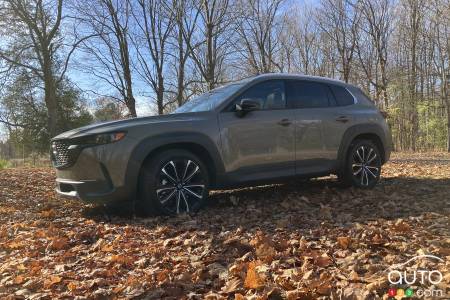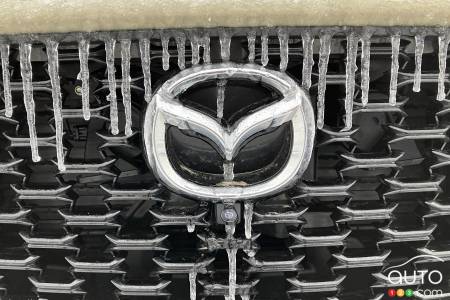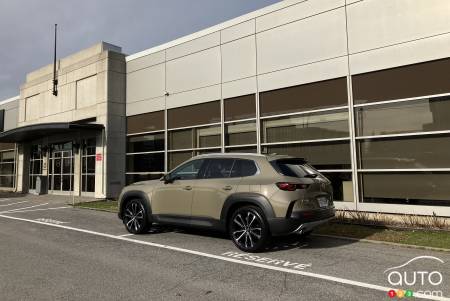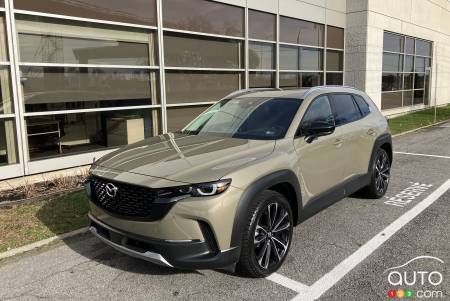Auto123 is putting the 2023 Mazda CX-50 to the long-term test. Today, part 3 of 6, as we try to put the importance of fuel economy versus power into perspective.
See also: 2023 Mazda CX-50 Long-Term Review, Part 1 : The start of something new
See also: 2023 Mazda CX-50 Long-Term Review, Part 2 : Dimensions, versions and mission
See also: 2023 Mazda CX-50 Long-Term Review, Part 4: A driving experience with multiple personalities
See also: 2023 Mazda CX-50 Long-Term Review, Part 5: We venture into the interior
See also: 2023 Mazda CX-50 Long-Term Review, Part 6: All good things must come to an end
At the moment, all Mazda models sold here use a 4-cylinder gasoline engine, except of course the MX-30 electric SUV. However, the automaker recently announced that by 2030, all of its North American models will include at least one hybrid, plug-in hybrid or 100-percent electric variant. In the case of the CX-50, for example, it will be a non-plug-in-hybrid version (with a boost from Toyota) for the 2024 model-year.
Browse cars for sale available near you

Which engine to choose?
In the meantime, the CX-50 gets by with a 2.5L, 16-valve SkyActiv-G engine. The two more affordable models (GS-L and GT) get the naturally aspirated version that makes 187 hp and 186 lb-ft of torque.
The GT Turbo and Meridian models also get a twin-scroll turbocharger, which is roughly equivalent to having two turbos instead of one.
I'd like to digress for a moment to remind you that the strength of Mazda's SkyActiv technology lies in its high compression ratio. The higher the compression ratio, the more power it generates, the less fuel it wastes and the less pollution it causes. In the CX-50's regular 2.5L, this ratio reaches 13:1, whereas 10:1 is the usual average (except for a diesel engine, which requires a much higher ratio because it can't rely on a sparkplug to ignite).
This means that, according to Mazda, you can get a 7.9L/100 km highway fuel consumption rating with the GS-L and GT models. To achieve this, the engine deactivates two of the four cylinders at cruising speeds to reduce fuel consumption.
For the GT Turbo tested during our long-term test drive, my best score has been 9.1L/100 km. And now that the cold weather has set in for good, I can't seem to get below 9.3L.
That said, I'm currently running the GT Turbo on regular gas (87 octane), which gives me 227 hp and 310 lb-ft of torque. Mazda says that if I were to use premium gasoline (93 octane), I would have 256 hp and 320 lb-ft of torque.

What type of gasoline should I choose for my CX-50?
A higher-octane rating reduces the risk of auto-ignition because it can handle warmer temperatures. It also promotes a higher compression ratio of the air-fuel mixture in the cylinders, which is the trademark of SkyActiv engines.
Except that the compression ratio of the 2.5L GT Turbo and Meridian is 10.5:1. Why lower than the other two models? Because the turbo already produces pressure in the cylinder. We don't want to overdo it and cause premature detonation. Hence the precaution taken with the higher-octane rating, which consoles us by granting us bonus horsepower.
In short, on the one hand, we have an engine that consumes less fuel and, therefore, costs less at the pump but is also less powerful. On the other hand, we have an engine that consumes more fuel and therefore costs more at the pump, but is also more powerful. Power and Cost that can even climb if we agree to switch to premium gasoline.
A dilemma? I'm not so sure.
Look at the current headlines. The spectre of a recession looms over us, the cost of groceries keeps rising, as do mortgage rates and gasoline prices. Under these conditions, do I really want to create another obligation to spend more to have extra horsepower?
In concrete terms, we're talking about a difference in acceleration. About 9 seconds to go from 0 to 100 km/h with the naturally aspirated 2.5L and 7 seconds for the turbocharged. Two seconds difference. Is it worth the expense? In a road network teeming with congestion, potholes, photo radar and T-RV-7s (yes, the code name for orange cones)? We think not.

On the other hand, there is a better reason to choose the more-expensive 2.5L: the towing capacity. With it, it's 1588 kg (3500 lb) while the regular 2.5L is limited to 907 kg (2000 lb), like the CX-5.
If the 2.5L turbo is necessary because you often have to tow stuff, the pill will be easier to swallow if you opt for regular gas. On the other hand, I think I’ll be feeding the CX-50 premium fuel over the next couple of weeks (I'll pass the bill on to the boss, they’ll love it). We'll see if the octane rating, in addition to providing me with more muscle, manages the seemingly contradictory feat of lowering my gas consumption.
Knowing that I'll be paying more for my gas, it's funny how I think I can guess the results of my experiment in advance. Unless I find one of those gas stations that offers premium gas at the same price as regular gas on a specific day of the week!
What components work with the CX-50's engines?
All four members of the lineup pair their engines with a 6-speed automatic transmission, with the turbo version adding paddle shifters.
And, like all double-digit CX models, the quartet gets i-Activ all-wheel drive. That's a given for a vehicle that's supposed to encourage its occupants to go out and play. But here's a new complication for our ideal budget.
“It's true that our all-wheel drive system has a small impact on fuel economy. When you compare fuel economy over the years, you'd think our models would have become more fuel-efficient, but that's due to the transition from a mix of FWD/AWD vehicles to AWD-only vehicles," says Chuck Reimer, director of product communications for Mazda Canada.
At least this is a fixed part of the equation that will determine which version of the CX-50 is best for us. To us and our budget.
Until we meet again, I just want to wish you a wonderful holiday season!
PS: To write me: michel.crepault@auto123.com





